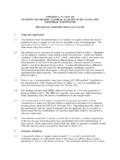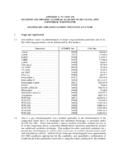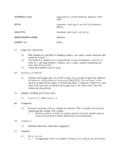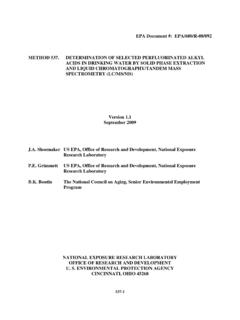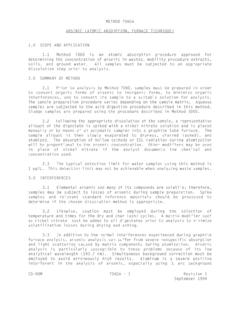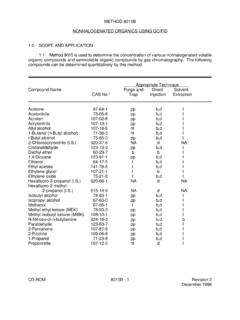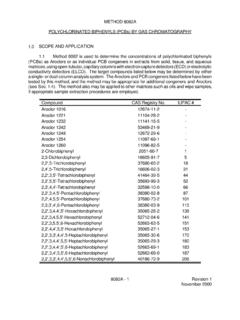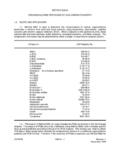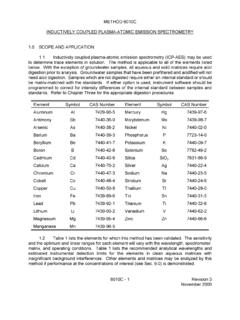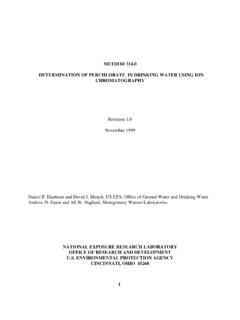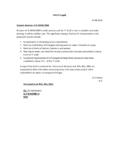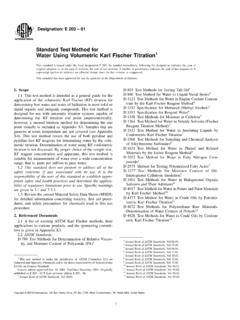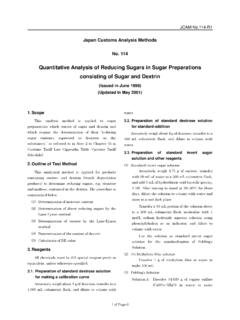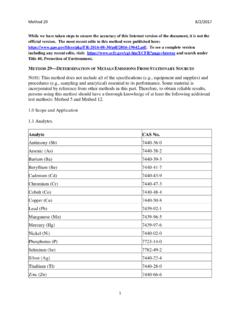Transcription of SW-846 Method 6010C: Inductively Coupled Plasma …
1 6010C - 1 Revision 3 February 2007 Method 6010 CINDUCTIVELY Coupled Plasma - atomic EMISSION SPECTROMETRYSW-846 is not intended to be an analytical training manual. Therefore, methodprocedures are written based on the assumption that they will be performed by analysts who areformally trained in at least the basic principles of chemical analysis and in the use of the addition, SW-846 methods , with the exception of required Method use for the analysisof Method -defined parameters, are intended to be guidance methods which contain generalinformation on how to perform an analytical procedure or technique which a laboratory can useas a basic starting point for generating its own detailed Standard Operating Procedure (SOP),either for its own general use or for a specific project application. The performance dataincluded in this Method are for guidance purposes only, and are not intended to be and mustnot be used as absolute QC acceptance criteria for purposes of laboratory SCOPE AND APPLICATION Coupled Plasma - atomic emission spectrometry (ICP-AES) may be usedto determine trace elements in solution.
2 With the exception of groundwater samples, allaqueous and solid matrices need acid digestion prior to analysis. Groundwater samples thatwere prefiltered and acidified will not need acid digestion. Samples which are not digestedneed either an internal standard or should be matrix-matched with the standards. If eitheroption is used, instrument software should be programmed to correct for intensity differences ofthe internal standard between samples and standards. Refer to Chapter Three, "InorganicAnalytes," for a listing of digestion procedures that may be appropriate. The following analyteshave been determined by this Method : ElementSymbolCAS NumberElementSymbolCAS NumberAluminumAl7429-90-5 MercuryHg7439-97-6 AntimonySb7440-36-0 Molybdenum Mo7439-98-7 ArsenicAs7440-38-2 Nickel Ni7440-02-0 Barium Ba7440-39-3 PhosphorusP7723-14-0 BerylliumBe7440-41-7 PotassiumK7440-09-7 BoronB7440-42-8 SeleniumSe7782-49-2 Cadmium Cd7440-43-9 SilicaSiO27631-86-9 Calcium Ca7440-70-2 SilverAg7440-22-4 Chromium Cr7440-47-3 SodiumNa7440-23-5 CobaltCo7440-48-4 StrotiumSr7440-24-6 Copper Cu7440-50-8 ThalliumTI7440-28-0 Iron Fe7439-89-6 TinSn7440-31-5 LeadPb7439-92-1 TitaniumTi7440-32-6 LithiumLi7439-93-2 VanadiumV7440-62-2 ElementSymbolCAS NumberElementSymbolCAS Number6010C - 2 Revision 3 February 2007 Magnesium Mg7439-95-4 ZincZn7440-66-6 ManganeseMn7439-96-5 CAS Number.
3 Chemical Abstract Service Registry 1 lists all of the elements for which this Method was validated. Thesensitivity and the optimum and linear ranges for each element will vary with the wavelength,spectrometer, matrix, and operating conditions. Table 1 lists the recommended analyticalwavelengths and estimated instrumental detection limits (IDLs) for the elements in cleanaqueous matrices with insignificant background interferences. Other elements and matricesmay be analyzed by this Method if appropriate performance at the concentrations of interest(see Sec. ) is should clearly understand the data quality objectives prior to analysis andmust document and have on file the required initial demonstration performance data describedin the following sections prior to using the Method for to employing this Method , analysts are advised to consult the eachpreparative Method that may be employed in the overall analysis ( , a 3000 series Method )for additional information on quality control procedures, development of QC acceptance criteria,calculations, and general guidance.
4 Analysts also should consult the disclaimer statement atthe front of the manual and the information in Chapter Two for guidance on the intendedflexibility in the choice of methods , apparatus, materials, reagents, and supplies, and on theresponsibilities of the analyst for demonstrating that the techniques employed are appropriatefor the analytes of interest, in the matrix of interest, and at the levels of concern. In addition, analysts and data users are advised that, except where explicitly specified in aregulation, the use of SW-846 methods is not mandatory in response to Federal testingrequirements. The information contained in this Method is provided by EPA as guidance to beused by the analyst and the regulated community in making judgments necessary to generateresults that meet the data quality objectives for the intended of this Method is restricted to use by, or under supervision of, spectroscopistsappropriately experienced and trained in the correction of spectral, chemical, and physicalinterferences described in this Method .
5 Each analyst must demonstrate the ability to generateacceptable results with this SUMMARY OF to analysis, samples must be solubilized or digested using the appropriatesample preparation methods (see Chapter Three). When analyzing groundwater samples fordissolved constituents, acid digestion is not necessary if the samples are filtered and acidpreserved prior to analysis (refer to Sec. ). Method describes multielemental determinations by ICP-AES using sequentialor simultaneous optical systems and axial or radial viewing of the Plasma . The instrumentmeasures characteristic emission spectra by optical spectrometry . Samples are nebulized andthe resulting aerosol is transported to the Plasma torch. Element-specific emission spectra areproduced by a radio-frequency Inductively Coupled Plasma . The spectra are dispersed by agrating spectrometer, and the intensities of the emission lines are monitored by photosensitivedevices. 6010C - 3 Revision 3 February correction is required for trace element determination.
6 Backgroundemission must be measured adjacent to analyte lines on samples during analysis. The positionselected for the background-intensity measurement, on either or both sides of the analyticalline, will be determined by the complexity of the spectrum adjacent to the analyte line. Theposition used should be as free as possible from spectral interference and should reflect thesame change in background intensity as occurs at the analyte wavelength measured. Background correction is not required in cases of line broadening where a backgroundcorrection measurement would actually degrade the analytical result. The possibility ofadditional interferences identified in Sec. should also be recognized and appropriatecorrections made; tests for their presence are described in Secs. and Alternatively,users may choose multivariate calibration methods . In this case, point selections forbackground correction are superfluous since whole spectral regions are DEFINITIONSR efer to Chapter One, Chapter Three, and the manufacturer's instructions for definitionsthat may be relevant to this , reagents, glassware, and other sample processing hardware may yieldartifacts and/or interferences to sample analysis.
7 All these materials must be demonstrated tobe free from interferences under the conditions of the analysis by analyzing Method blanks. Specific selection of reagents and purification of solvents by distillation in all-glass systems maybe necessary. Refer to each Method to be used for specific guidance on quality controlprocedures and to Chapter Three for general guidance on the cleaning of glassware. Also referto the preparative methods to be used for discussions on interferences are caused by background emission from continuous orrecombination phenomena, stray light from the line emission of high concentration elements,overlap of a spectral line from another element, or unresolved overlap of molecular bandspectra. for background emission and stray light can usually beconducted by subtracting the background emission determined by measurementsadjacent to the analyte wavelength peak. Spectral scans of samples or single elementsolutions in the analyte regions may indicate when alternate wavelengths are desirablebecause of severe spectral interference.
8 These scans will also show whether the mostappropriate estimate of the background emission is provided by an interpolation frommeasurements on both sides of the wavelength peak or by measured emission on onlyone side. The locations selected for the measurement of background intensity will bedetermined by the complexity of the spectrum adjacent to the wavelength peak. Thelocations used for routine measurement must be free of off-line spectral interference(interelement or molecular) or adequately corrected to reflect the same change inbackground intensity as occurs at the wavelength peak. For multivariate methods usingwhole spectral regions, background scans should be included in the correction algorithm. Off-line spectral interferences are handled by including spectra on interfering species inthe algorithm. determine the appropriate location for off-line background correction,the user must scan the area on either side adjacent to the wavelength and record theapparent emission intensity from all other Method analytes.
9 This spectral information must6010C - 4 Revision 3 February 2007be documented and kept on file. The location selected for background correction must beeither free of off-line interelement spectral interference or a computer routine must beused for automatic correction on all determinations. If a wavelength other than therecommended wavelength is used, the analyst must determine and document both theoverlapping and nearby spectral interference effects from all Method analytes andcommon elements and provide for their automatic correction on all analyses. Tests todetermine spectral interference must be done using analyte concentrations that willadequately describe the interference. Normally, 100 mg/L single-element solutions aresufficient. However, for analytes such as iron that may be found in the sample at highconcentration, a more appropriate test would be to use a concentration near the upperlimit of the analytical range (refer to Chapter Three). overlaps may be avoided by using an alternate wavelength orcan be compensated for by equations that correct for interelement contributions.
10 Instruments that use equations for interelement correction require that the interferingelements be analyzed at the same time as the element of interest. When operative anduncorrected, interferences will produce false positive or positively biased determinations. More extensive information on interferant effects at various wavelengths and resolutions isavailable in reference wavelength tables and books. Users may apply interelementcorrection equations determined on their instruments with tested concentration ranges tocompensate (off-line or on-line) for the effects of interfering elements. Some potentialspectral interferences observed for the recommended wavelengths are given in Table 2. For multivariate calibration methods using whole spectral regions, spectral interferencesare handled by including spectra of the interfering elements in the algorithm. Theinterferences listed are only those that occur between Method analytes. Onlyinterferences of a direct overlap nature are listed.
